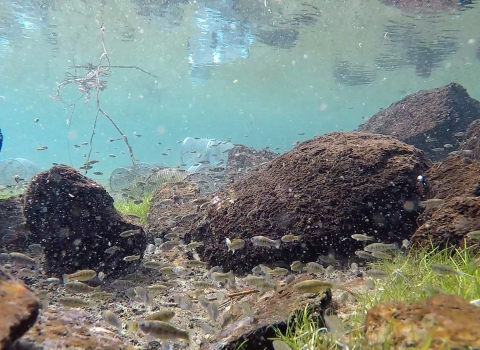Each year the nation’s federal wildland fire community battles wildfires all across the nation. Individuals from the Department of the Interior’s Bureau of Land Management, National Park Service, U.S. Fish and Wildlife Service, and Bureau of Indian Affairs; and the U.S. Department of Agriculture’s Forest Service come together to safeguard communities and protect our nation’s natural and cultural treasures from being lost to fire.
These wildfire incidents often require hundreds of individuals congregating in small communities or in remote camps reminiscent of military outposts. These camps serve as hubs to support firefighting and public outreach operations. Often these wildfire incidents occur on federal lands adjacent to communities that require the government's help to preserve life and property.
Federal law enforcement officers come from all over the country to help with the wildfires. They do everything –assisting in the evacuation of local communities, enforcing federal land closures, ensuring the safety of personnel and equipment within the camps, securing accident scenes, protecting sensitive government property like aircraft, and even fighting fire if needed.
Currently, New Mexico is experiencing the largest wildfire in the state’s history. On April 6, 2022, the Hermits Peak Fire started burning 12 miles northwest of Las Vegas, New Mexico, at the base of Hermits Peak in the Pecos Wilderness. On April 19, 2022, the Calf Canyon Fire emerged, and the two fires grew to over 335,000 acres, burning through heavy mixed conifer, ponderosa pine, brush, and grass of the National Forest. At its height, approximately 3,000 personnel were assigned to the incident requiring a sizable infrastructure to support efforts.
From the onset of the incident, resources have been extremely hard to obtain. From personnel to equipment, incident teams have been faced with shortages while trying to tame the fires. The law enforcement program of our National Wildlife Refuge System is small compared with other federal law enforcement agencies – only 233 commissioned officers within its ranks. Although small in numbers, federal wildlife officers always answer the call of the American people, and this incident was no different. Once the call went out, federal wildlife officers responded from all over the Unites States, making up the majority of the federal law enforcement officers on the incident.
To date over 25 federal wildlife officers have answered the call to serve the American people and citizens of New Mexico in their hour of need. Federal wildlife officers were sent to the far corners of the incident on short notice to manage checkpoints, assist citizens, preserve accident scenes, remove disorderly individuals from camps, and investigate criminal activity. They’re also connecting with fire personnel in camp and educating them on the cultural resources in the area. There hasn’t been a challenge or assignment that wasn’t met and executed with enthusiasm and professionalism. The incident management team was extremely impressed that they didn’t have to think about law enforcement issues and commented on the fact that federal wildlife officers have a reputation for being solid dependable officers in the fire world.
It’s always tough when a federal wildlife officer leaves their area of responsibility because often there isn’t another officer to pick up the slack while they are on assignment. But that doesn’t stop federal wildlife officers from exemplifying public service whenever they are called to help.






